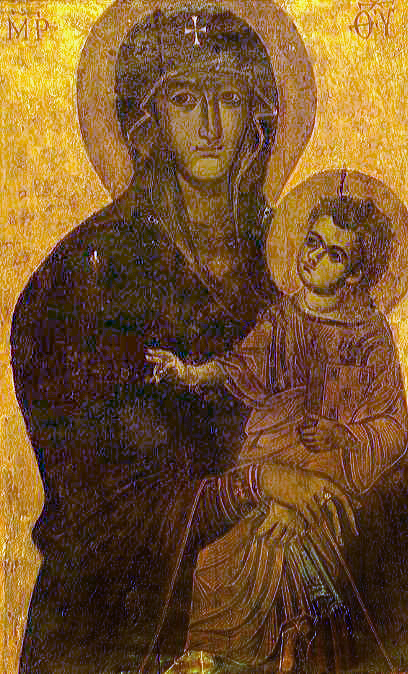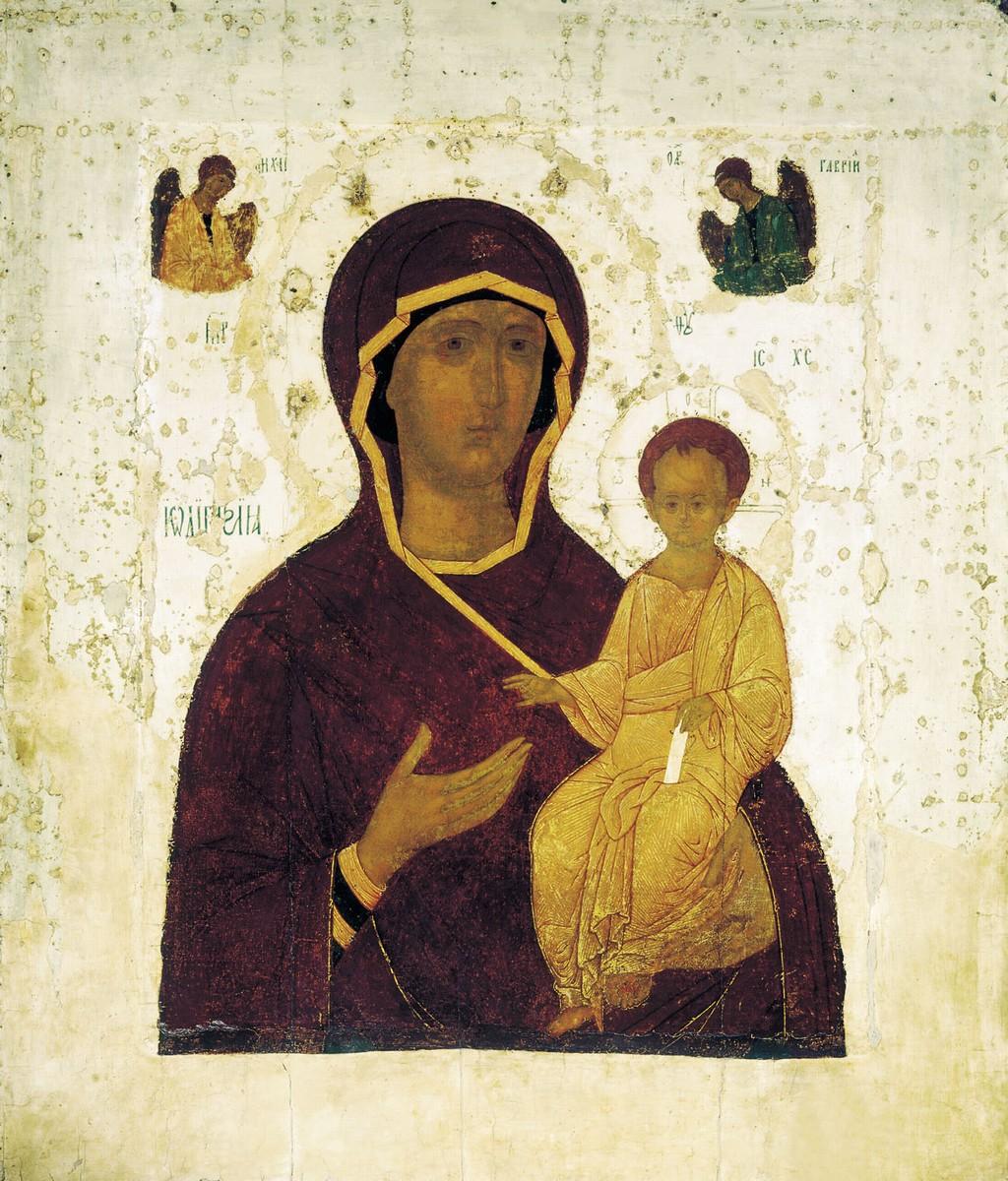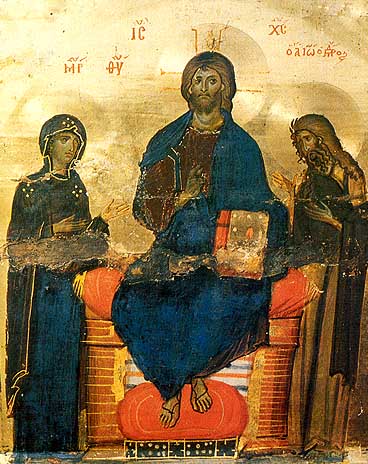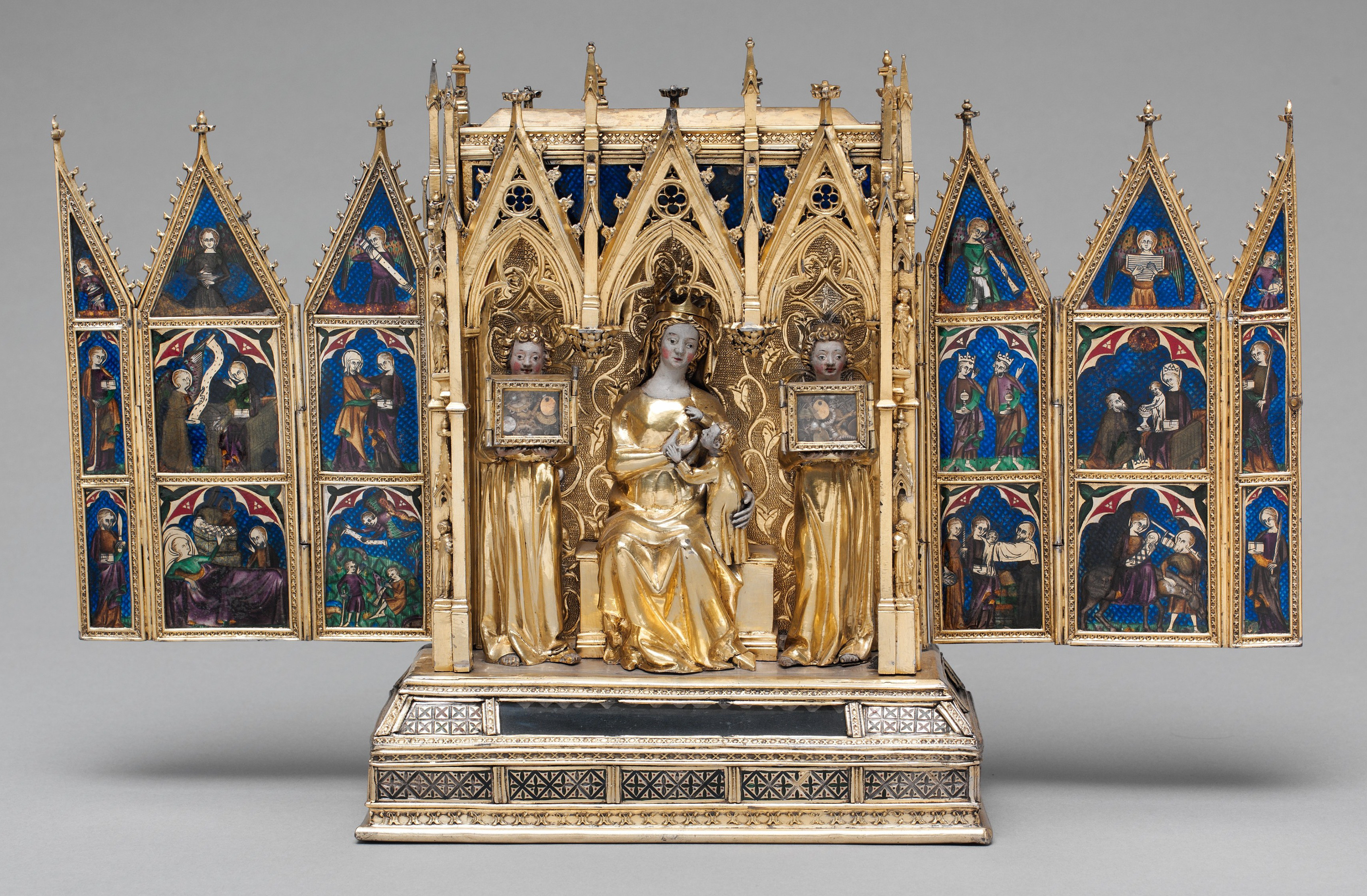|
Agiosoritissa
The Panagia Agiosoritissa or Hagiosoritissa () is the name for a type of Marian icon, showing Mary without the Christ Child, slightly from the side with both hands raised in prayer. The type is known in Latin as Maria Advocata. Names The names used for the icon, ''Hagiosoritissa'' and, in Russian, ''Khalkopratiskaya'' (), derive from the church of the Holy Urn (Greek: Ἁγία Σορός, in reference to the urn containing the Cincture of the Theotokos) in Constantinople's Chalkoprateia (Χαλκοπρατεῖα, "copper market") district. In English, the type is also known as ''Madonna Advocate'' (the prayer gesture interpreted as an act of intercession on behalf of the faithful). History The appellation Ἁγιοσορίτισσα is first recorded in Byzantine seals of the 11th century, and it appears minted on coins made under Manuel I Komnenos (). The type was widespread in the Byzantine empire and in the Balkans, but less so in Russia. Examples Such an icon is kn ... [...More Info...] [...Related Items...] OR: [Wikipedia] [Google] [Baidu] |
Madonna Advocata
The Panagia Agiosoritissa or Hagiosoritissa () is the name for a type of Marian icon, showing Mary without the Christ Child, slightly from the side with both hands raised in prayer. The type is known in Latin as Maria Advocata. Names The names used for the icon, ''Hagiosoritissa'' and, in Russian, ''Khalkopratiskaya'' (), derive from the church of the Holy Urn (Greek: Ἁγία Σορός, in reference to the urn containing the Cincture of the Theotokos) in Constantinople's Chalkoprateia (Χαλκοπρατεῖα, "copper market") district. In English, the type is also known as ''Madonna Advocate'' (the prayer gesture interpreted as an act of intercession on behalf of the faithful). History The appellation Ἁγιοσορίτισσα is first recorded in Byzantine seals of the 11th century, and it appears minted on coins made under Manuel I Komnenos (). The type was widespread in the Byzantine empire and in the Balkans, but less so in Russia. Examples Such an icon is know ... [...More Info...] [...Related Items...] OR: [Wikipedia] [Google] [Baidu] |
Madonna (art)
In Christian art, a Madonna () is a religious depiction of the Blessed Virgin Mary in a singular form or sometimes accompanied by the Child Jesus. These images are central icons for both the Roman Catholic and Eastern Orthodox Church, Orthodox churches. The word is (archaic). The Madonna and Child type is very prevalent in Christian iconography, divided into many traditional subtypes especially in Eastern Orthodox iconography, often known after the location of a notable icon of the type, such as the ''Theotokos of Vladimir'', ''Agiosoritissa'', ''Blachernitissa'', etc., or descriptive of the depicted posture, as in ''Hodegetria'', ''Eleusa icon, Eleusa'', etc. The term ''Madonna'' in the sense of "picture or statue of the Virgin Mary" enters English usage in the 17th century, primarily in reference to works of the Italian Renaissance. In an Eastern Orthodox context, such images are typically known as ''Theotokos''. "Madonna" may be generally used of representations of Mar ... [...More Info...] [...Related Items...] OR: [Wikipedia] [Google] [Baidu] |
Theotokos Of Bogolyubovo
''Theotokos'' (Greek: ) is a title of Mary, mother of Jesus, used especially in Eastern Christianity. The usual Latin translations are or (approximately "parent (fem.) of God"). Familiar English translations are "Mother of God" or "God-bearer" – but these both have different literal equivalents in , and Θεοφόρος respectively. The title has been in use since the 3rd century, in the Syriac tradition (as ) in the Liturgy of Mari and Addai (3rd century)''Addai and Mari, Liturgy of''. Cross, F. L., ed. ''The Oxford Dictionary of the Christian Church''. Oxford University Press. 2005. and the Liturgy of St James (4th century). The Council of Ephesus in AD 431 decreed that Mary is the ''Theotokos'' because her son Jesus is both God and man: one divine person from two natures (divine and human) intimately and hypostatically united. The title of Mother of God (Greek: ) or Mother of Incarnate God, abbreviated ΜΡ ΘΥ (the first and last letter of main two words in Gr ... [...More Info...] [...Related Items...] OR: [Wikipedia] [Google] [Baidu] |
Santi Bonifacio Ed Alessio
The Basilica dei Santi Bonifacio e(d) Alessio is a basilica, rectory church served by the Somaschans, and titular church for a cardinal-priest on the Aventine Hill in the third prefecture of central Rome, Italy. It is dedicated to Saint Boniface of Tarsus and Saint Alexius, the former the original and the latter added in the 10th century. It lies on Piazza Sant’Alessio 23, near the historical gardens of St. Alexius and Via di santa Sabina. Basilica Founded between the 3rd and 4th centuries, it was restored in 1216 by Pope Honorius III (some columns of his building survive in the present building's eastern apse); in 1582; in 1743 designed by Giovanni Battista Nolli and in the 1750s reelaborated by Tommaso De Marchis (his main altar survives); and between 1852 and 1860 by the Somaschi Fathers, who still serve it as a rectory church. The 16th century style façade, elaborated from the De Marchis phase, is built onto the medieval-style quadriportico. The church has a R ... [...More Info...] [...Related Items...] OR: [Wikipedia] [Google] [Baidu] |
7th-century Paintings
The 7th century is the period from 601 through 700 in accordance with the Julian calendar in the Christian Era. The spread of Islam and the Muslim conquests began with the unification of Arabia by the Islamic prophet Muhammad starting in 622. After Muhammad's death in 632, Islam expanded beyond the Arabian Peninsula under the Rashidun Caliphate (632–661) and the Umayyad Caliphate (661–750). The Muslim conquest of Persia in the 7th century led to the downfall of the Sasanian Empire. Also conquered during the 7th century were Syria, Palestine, Armenia, Egypt, and North Africa. The Byzantine Empire suffered setbacks during the rapid expansion of the Caliphate and a mass incursion of Slavs in the Balkans which reduced its territorial limits. The decisive victory at the Siege of Constantinople in the 670s led the empire to retain Asia Minor, which ensured the existence of the empire. In the Iberian Peninsula, the 7th century was known as the ''Siglo de Concilios'' (century o ... [...More Info...] [...Related Items...] OR: [Wikipedia] [Google] [Baidu] |
Salus Populi Romani
''Salus Populi Romani'' (English: ''Protectress of the Roman people'', also known as the ''Salvific Health of the Roman people'') is a Roman Catholic title associated with the venerated image of the Blessed Virgin Mary in Rome. This Byzantine icon of the Madonna and Child Jesus holding a Gospel book on a gold ground, now heavily overpainted, is kept in the Borghese (Pauline) Chapel of the Basilica of Saint Mary Major.''Relics'' by Joan Carroll Cruz 1984 page 96 The image arrived in Rome in 590 A.D. during the reign of Pope Gregory I. Pope Gregory XVI granted the image a canonical coronation on 15 August 1838 through the Papal bull ''Cælestis Regina Maxima''. Pope Pius XII crowned the image again for the secondary time and ordered a public religious procession during the Marian year of 1 November 1954. The image was cleaned and restored by the Vatican Museum, then given a Pontifical Mass on 28 January 2018. The phrase ''Salus Populi Romani'' goes back to the legal syst ... [...More Info...] [...Related Items...] OR: [Wikipedia] [Google] [Baidu] |
Hodegetria
A Hodegetria, or Virgin Hodegetria, is an iconography, iconographic depiction of the Theotokos (Virgin Mary) holding the Child Jesus at her side while pointing to him as the source of salvation for humankind. The Virgin's head usually inclines towards the child, who raises his hand in a blessing gesture. Metals are often used to draw attention to young Christ, reflecting light and shining in a way to embody divinity. In the Western Church this type of icon is sometimes called Our Lady of the Way. The most venerated icon of the Hodegetria type, regarded as the original, was displayed in the Hodegon Monastery, Monastery of the Panaghia Hodegetria in Constantinople, which was built specially to contain it. Unlike most later copies it showed the Theotokos standing full-length. It was said to have been brought back from the Holy Land by Aelia Eudocia, Eudocia, the wife of emperor Theodosius II (408–450), and to have been painted by Saint Luke the evangelist, the attributed author of ... [...More Info...] [...Related Items...] OR: [Wikipedia] [Google] [Baidu] |
Deesis
In Byzantine art, and in later Eastern Orthodox iconography generally, the Deësis or Deisis (, ; , "prayer" or "supplication") is a traditional iconic representation of Christ in Majesty or Christ Pantocrator: enthroned, carrying a book, and flanked by the Virgin Mary and St. John the Baptist, and sometimes other saints and angels. Mary and John, and any other figures, are shown facing towards Christ with their hands raised in supplication on behalf of humanity. Early examples often appeared on the templon beam in Orthodox churches or above doors, though icons and devotional ivories also feature the Deesis. After the development of the full iconostasis screen there was room for a larger "Deesis row" or "Great Deesis" of full-length figures, and the number of figures expanded, both in Byzantium and in Russia. Usually this row is above the level of the doors, and usually below (sometimes above) the row depicting the Twelve Great Feasts. The central Christ is therefore a ... [...More Info...] [...Related Items...] OR: [Wikipedia] [Google] [Baidu] |
Blachernitissa
Blachernitissa (), also called Theotokos of Blachernae (Θεοτόκος των Βλαχερνών, Θεοτόκος η Βλαχερνίτισσα) or Our Lady of Blachernae (Παναγία η Βλαχερνίτισσα), is a 7th-century encaustic icon representing the ''Most Holy Theotokos and Ever-Virgin Mary''. It is also the name given to the Church built in honour of the Virgin Mary in the Blachernae section of Constantinople. The name Blachernae possibly derived from the name of a Vlach (sometimes written as Blach or Blasi), who came to Constantinople from the lower Danube. Byzantine palladium The Theotokos was considered to be the intercessory protectress ''par excellence'' of Constantinople and, indeed, of the entire Eastern Roman Empire (called "Byzantium" by some modern Western scholars). ''Blachernitissa'' is unusual among Orthodox icons in that it is not flat, but is formed in bas relief. According to Sacred Tradition, the icon ''Blachernitissa'' was ... [...More Info...] [...Related Items...] OR: [Wikipedia] [Google] [Baidu] |
Byzantine Dress
Byzantine dress changed considerably over the thousand years of the Empire, but was essentially conservative. The Byzantines liked colour and pattern, and made and exported very richly patterned cloth, especially Byzantine silk, woven and embroidered for the upper classes, and resist-dyed and printed for the lower. A different border or trimming round the edges was very common, and many single stripes down the body or around the upper arm are seen, often denoting class or rank. Taste for the middle and upper classes followed the latest fashions at the Imperial Court. As in the West during the Middle Ages, clothing was very expensive for the poor, who probably wore the same well-worn clothes nearly all the time;Payne, Blanche; Winakor, Geitel; Farrell-Beck Jane: ''The History of Costume, from the Ancient Mesopotamia to the Twentieth Century'', 2nd Edn, p128, HarperCollins, 1992. this meant in particular that any costume owned by most women needed to fit throughout the full leng ... [...More Info...] [...Related Items...] OR: [Wikipedia] [Google] [Baidu] |
Cloisonné
Cloisonné () is an ancient technology, ancient technique for decorating metalwork objects with colored material held in place or separated by metal strips or wire, normally of gold. In recent centuries, vitreous enamel has been used, but inlays of cut gemstones, glass and other materials were also used during older periods; indeed cloisonné enamel very probably began as an easier imitation of cloisonné work using gems. The resulting objects can also be called cloisonné. The decoration is formed by first adding compartments (''cloisons'' in French) to the metal object by soldering or affixing silver or gold as wires or thin strips placed on their edges. These remain visible in the finished piece, separating the different compartments of the enamel or inlays, which are often of several colors. Cloisonné enamel objects are worked on with enamel powder made into a paste, which then needs to be fired in a kiln. If gemstones or colored glass are used, the pieces need to be cut o ... [...More Info...] [...Related Items...] OR: [Wikipedia] [Google] [Baidu] |
Reliquary
A reliquary (also referred to as a ''shrine'', ''Chasse (casket), chasse'', or ''phylactery'') is a container for relics. A portable reliquary, or the room in which one is stored, may also be called a ''feretory''. Relics may be the purported or actual physical remains of saints, and may comprise bones, pieces of clothing, or some object associated with saints or with other religious figures. The authenticity of any given relic is often a matter of debate; for that reason, some churches require documentation of a relic's provenance. Relics have long been important to Buddhism, Buddhists, Christianity , Christians, Hinduism , Hindus, and to followers of many other religions. These cultures often display reliquaries in shrines, churches, or temples to which the faithful make pilgrimages to gain blessings. The term is sometimes used in a looser sense to mean a container for the remains of any important figure, even non-religious ones. In particular, the kings of France often spe ... [...More Info...] [...Related Items...] OR: [Wikipedia] [Google] [Baidu] |










